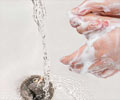A unique mechanism behind increased survival ability of infectious hospital based pathogen P.aeruginosa, was found by scientists at University of Maryland.
- A research team from the University of Maryland has found the mechanism that allows P.aeruginosa to survive under sudden excess of water.
- These organisms have special channels on their cell surface that are activated during water build up inside the organism.
- They allow water out of the cell to maintain water level and to prevent bloating and bursting.
P. aeruginosa's Adaptability
P.aeruginosa can survive in very harsh environments and one of the main reasons behind their adaptability is that they can survive sudden increase in water. During rainfall, there would be an increase in water level surrounding bacteria and this leads to osmotic entry of water into the cell. As the water continues to enter, the cells burst after swelling and die. However, in certain bacteria, including the gut bacteria Escherichia coli, once the level of water inside the cell increase beyond a certain level, mechano-sensitive channels in the walls of the bacterium open. This allows small osmolytes to leave the cell, thereby preventing the cell from swelling up.A research team from the University of Maryland led by Dr. Sergei Sukharev discovered through their experimental studies that P. aeruginosa can tolerate larger amounts of osmotic shocks when compared to E. coli. The higher adaptability of P. aeruginosa could be due to lowered permeability to water and its ability to release osmolytes faster.
Advantage of P.aeruginosa
- Lowered permeability to water
- Releases osmolytes faster
- Increased time available for the cell to respond to osmotic shocks due to lower water permeability.
- Nearly 20% of the organism’s dry weight is reduced within a period of 28 milliseconds.
The mechano-sensitive channels that are expressed by P.aeruginosa are:
MscL- The organism has one type of MscL channel. This type of channel predominates and is present at a far greater density in P.aeruginosa than in E.coli. This leads to the release of more number of large osmolytes from the organism.
Dr. Sukharev said that the current study would help in gaining a better understanding of how the physiological response to osmotic pressure occurs in bacteria and the adaptations that they carry to survive it. The study also showed that P. aeruginosa had a better osmotic stability when compared to E. coli.
P.aeruginosa in Hospitals
Pseudomonas aeruginosa is a well-known nosocomial pathogen, affecting people during hospitalization. The incidence of P. aeruginosa in the U.S hospitals is- 0.4 percent (4 per 1000 discharges)
- It is the fourth most common nosocomial pathogen
- It accounts for 10.1% of all infections acquired at hospitals.
The current study conducted by Dr. Sukharev and colleagues show that the ability of the organism to survive in an environment in sudden water rich environment which is evidenced by the presence of this organism in numerous reservoirs in the hospital like
- Taps
- Sinks
- Mops
- Disinfectants
- Respiratory equipment
References:
- Incidence of Multidrug Resistant Pseudomonas Aeruginosa Isolated from Burn Patients and Environment of Teaching Institution - (https://www.ncbi.nlm.nih.gov/pmc/articles/PMC4080000/)
- Resistance Pattern of Pseudomonas aeruginosa in a Tertiary Care Hospital of Kanchipuram, Tamilnadu, India - (https://www.ncbi.nlm.nih.gov/pmc/articles/PMC4080001/)
- https://www.eurekalert.org/pub_releases/2017-04/rup-nse041217.php - (New study explains extraordinary resilience of deadly bacterium)
- Pseudomonas aeruginosa in Healthcare Settings - (https://www.cdc.gov/hai/organisms/pseudomonas.html)
Source-Medindia











